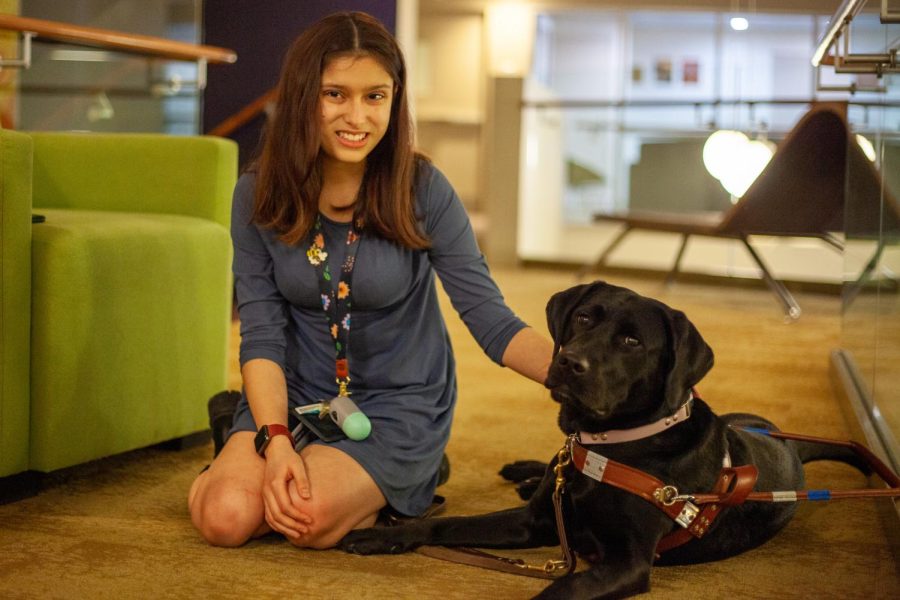Joicee Gordillo, a sophomore psychology major at Suffolk University, and her guide dog Junie have been inseparable since they were paired in August of 2021. This comes as no surprise, as Junie helps Joicee get around in difficult areas of a city that isn’t always easy to navigate.
Gordillo is legally blind, which is a government-defined term to determine if one is able to receive certain benefits for their disability. According to Webmd, if you’re legally blind, your vision is 20/200 at most or in your better eye, or your field of vision is less than 20 degrees.
If an object is 200 feet away, you have to stand 20 feet from it in order to see it clearly. But a person with normal vision can stand 200 feet away and see that object perfectly.
“People assume being blind means you can’t see anything… I’m legally blind but I can still see,” said Gordillo. “Blindness is a spectrum; there are people who can see light and colors and then there are people who can only see little bits of light. I have central vision.”
Gordillo was diagnosed with optic nerve hypoplasia when she was born, which means she has an underdeveloped optic nerve in her right eye, as well as no optic nerve in her left eye.
Gordillo uses both her guide dog Junie as well as a white cane to navigate. While Suffolk students may see the pair together between classes, Gordillo explained that she uses the two aids for different purposes.
“The white cane is good for helping to find obstacles while a guide dog will avoid the obstacles. So you might not even know the obstacle is there when you have a guide dog because they’ll avoid it,” said Gordillo.
According to the Perkins School for the Blind, most people who are visually impaired don’t use a white cane, with between 2-8% using the aid.
Even with the use of aides such as a white cane and guide dog, living in an urban landscape comes with challenges in a historic city like Boston that still has areas that aren’t updated.
Places such as Government Center with its uneven stairs and Faneuil Hall with its uneven cobblestone paths can be a challenge for the blind community. Gordillo struggles with depth perception, so non-standard stairs pose an issue.
“My main issue when I first moved here was Government Center. The stairs next to it are really wide and steep. I would miss them, and have almost tripped and hurt myself because they’re not marked, so there is no way for me to know the change of depth,” Gordillo said.
Even outside of Suffolk’s 73 Tremont building, uneven bricks and the Freedom Trail present a challenge.
“The Freedom Trail isn’t tactile, it blends in with the rest of the brick. There are cities that have trails that go to certain places and are designed for the blind. But this one is a historic trail that isn’t designed for the blind,” said Gordillo. “ [The difficulty] is mostly just the camouflage of the brick.”
Gordillo applied for a guide dog in her senior year of high school, which she likens to the college application process a student would go through. She detailed how she needed to explain why she needed a guide dog, paperwork from multiple doctors, and both phone and home interviews, including videos of her walking her usual routine so they could match her with a dog that fit her pace and environment.
After being approved to have a guide dog, the matching process began and five months later, the pair trained together for two weeks. Unfortunately, Junie fell ill and was unable to begin officially working with Gordillo until October.
Despite the recency of their partnership, Gordillo and Junie have an undeniable bond, whether it’s on the way to class or exploring on the Red Line.
“Everyone tells me she gives me these eyes when she looks at me… I just feel special having her,” said Gordillo.
Gordillo explained how Junie is like her shadow. Almost anywhere she goes, Junie is allowed to be there.
“Because service dogs perform a task to mitigate symptoms of a disability, and it’s not just their existence that helps, they have public access rights as long as they have good behavior,” she said.
This means that service dogs are allowed to enter places where pets aren’t allowed, and hotels can’t charge Gordillo an extra fee for Junie. According to Gordillo, service dogs act as a piece of medical equipment.
One of the frustrations Gordillo faces is the rise in the number of people bringing their pets into stores and passing them off as trained service animals.
“A barking dog or if a dog were to lunge at her, it could pose a threat to our safety. She’s a dog, she can be distracted,” said Gordillo. “Your dog being a pet and not being well trained can interfere with other service dogs and could possibly pose a threat.”
Another issue Gordillo explained that she deals with is the lack of understanding of service dog etiquette, especially when the dog is working.
“A guide dog is working when they have the harness on. When it’s off, they’re just like any other dog. It depends on the service dog, the law doesn’t require them to wear any identifying gear. I need the harness to hold the handle so she can guide me, but other dogs don’t,” said Gordillo.
As a rule of thumb, Gordillo says you should ask to pet any dog. Gordillo explained how people shouldn’t make noises at a guide dog or call out to them when they’re working. This includes making eye contact with the dog for an extended period of time to garner their attention since they are focused on the task at hand.
Despite the challenges she may face, Gordillo credits her family for treating her like other kids her age.
“One of the things that I appreciated was that my parents raised me like any other kid,” said Gordillo. “They didn’t place an emphasis on me being blind.”





















